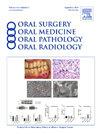Using thickened lamina dura as a predictor of developing medication-related osteonecrosis of the jaw (MRONJ)
IF 2
3区 医学
Q2 DENTISTRY, ORAL SURGERY & MEDICINE
Oral Surgery Oral Medicine Oral Pathology Oral Radiology
Pub Date : 2025-02-04
DOI:10.1016/j.oooo.2024.11.049
引用次数: 0
Abstract
Objective
The etiology of the radiographic finding, lamina dura thickening, in medication-related osteonecrosis of the jaw (MRONJ), is unknown but thought to be a result of osteoclastic inhibition by antiresorptive medication. Given that lamina dura thickening is present in all stages of MRONJ, this study hypothesizes that a thickened lamina dura may act as a surrogate marker for excessive osteoclastic inhibition and can serve as a predictor of the exposed-variant of MRONJ prior to tooth extraction.
Study Design
This retrospective case-control study evaluated patients with multiple myeloma who were taking antiresorptive medications and were treated at the Princess Margaret Hospital Dental Oncology Clinic (Toronto, Canada) between December 2011 and December 2021. Patients were eligible if they were taking antiresorptive medications (bisphosphonates or denosumab), had undergone 1 or more tooth extractions with accompanying diagnostic preoperative radiographs, and had documented follow-up of at least 8 weeks postextraction. Patients were excluded if they had any previous diagnosis of MRONJ or previous radiation to the head and neck. Three oral and maxillofacial radiologists were trained to identify and assess the lamina dura thickening quantitatively and qualitatively.
Results
This study will discuss the findings from analyzing 50 cases. Cases were 1:1 age-sex matched with controls. Data were collected regarding MRONJ diagnosis, tooth extraction and last follow-up dates, type of antiresorptive medication, and lamina dura thickness (determined using pre-extraction radiographs). Parameters were defined for normal, thickened, and very thickened lamina dura.
Conclusion
The results of this study will serve to inform future research on risk factors for MRONJ development. Furthermore, it can be used by dentists to properly inform their patients about their specific risk of developing MRONJ pre-operatively.
求助全文
约1分钟内获得全文
求助全文
来源期刊

Oral Surgery Oral Medicine Oral Pathology Oral Radiology
DENTISTRY, ORAL SURGERY & MEDICINE-
CiteScore
3.80
自引率
6.90%
发文量
1217
审稿时长
2-4 weeks
期刊介绍:
Oral Surgery, Oral Medicine, Oral Pathology and Oral Radiology is required reading for anyone in the fields of oral surgery, oral medicine, oral pathology, oral radiology or advanced general practice dentistry. It is the only major dental journal that provides a practical and complete overview of the medical and surgical techniques of dental practice in four areas. Topics covered include such current issues as dental implants, treatment of HIV-infected patients, and evaluation and treatment of TMJ disorders. The official publication for nine societies, the Journal is recommended for initial purchase in the Brandon Hill study, Selected List of Books and Journals for the Small Medical Library.
 求助内容:
求助内容: 应助结果提醒方式:
应助结果提醒方式:


